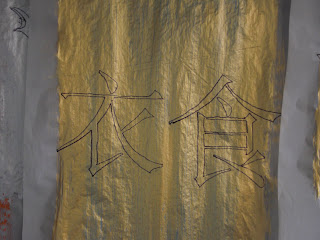
Form/Space Atelier Program for July 2010
Show Title: "1 Eightfold Six Trinity"
Show Duration: July 15-August 15, 2010
Vernissage: July 15, 2010, 6PM as part of 3rd Thursday www.BELLTOWNARTWALK.com
1 Eightfold Six Trinity is large scale works on paper, calligraphic
elements rendered in ink, over grounds of orange/silver or blue/gold. Shinto clerics collaborated as a group anonymously to produce the parchments; the objects were collected by Curator Paul Pauper during a recent trip to San Francisco’s Japantown.
1 Eightfold Six Trinity seeks to alter Form/Space Atelier into a shrine-like edifice where refuge from the incomprehensible agitations of the material world will evaporate, diminish and disappear forever.
Shinto has very ancient roots in the Japanese islands. The recorded history dates to the Kojiki (712) and Nihon Shoki (720), but archeological records date back significantly further. Both are compilations of prior oral traditions. The Kojiki establishes the Japanese imperial family as the foundation of Japanese culture, being the descendants of Amaterasu Omikami. There is also a creation myth and a genealogy of the gods.
The Nihonshoki was more interested in creating a structural system of government, foreign policy, religious hierarchy, and domestic social order.
There is an internal system of historical Shinto development that configures the relationships between Shinto and other religious practices over its long history; the inside and outside Kami(spirits). The inside or ujigami (uji meaning clan) Kami roles that supports cohesion and continuation of established roles and patterns; and the hitogami or outside Kami, bringing innovation, new beliefs, new messages, and some instability.
Jomon peoples of Japan used natural housing, predated rice farming, and frequently were hunter-gatherers, the physical evidence for ritual practices are difficult to document. There are many locations of stone ritual structures, refined burial practices and early Torii that lend to the continuity of primal Shinto. The Jomon had a clan based tribal system developed similar to much of the worlds indigenous people. In the context of this clan based system, local beliefs developed naturally and when assimilation between clans occurred, they also took on some beliefs of the neighboring tribes. At some point there was a recognition that the ancestors created the current generations and the reverence of ancestors (tama)took shape. There was some trade amongst the indigenous peoples within Japanese islands and the mainland, as well as some varying migrations. The trade and interchange of people helped the growth and complexity of the peoples spirituality by exposure to new beliefs. The natural spirituality of the people appeared to be based on the worship of nature forces or mono, and the natural elements to which they all depended.
The gradual introduction of methodical religious and government organizations from mainland Asia starting around 300 BCE seeded the reactive changes in primal Shinto over the next 700 years to a more formalized system. These changes were directed internally by the various clans frequently as a syncratic cultural event to outside influences. Eventually as the Yamato gained power a formalization process began. The genesis of the Imperial household amnd subsequent creation of the Kojiki helped facilitate the continuity needed for this long term development through modern history. There is today a balance between outside influences of Buddhist, Confucian, Taoist, Abrahamic, Hindu and secular beliefs. In more modern times Shinto has developed new branches and forms on a regular basis, including leaving Japan.
